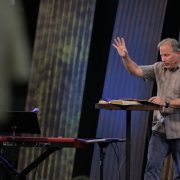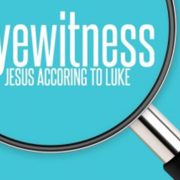The Right Foundation
/1 Comment/in Weekly Devotional/by David GuzikTherefore thus says the Lord God: “Behold, I lay in Zion a stone for a foundation, a tried stone, a precious cornerstone, a sure foundation; whoever believes will not act hastily. Also I will make justice the measuring line, and righteousness the plummet; the hail will sweep away the refuge of lies, and the waters will overflow the hiding place.” (Isaiah 28:16-17)
Isaiah 28 is an amazing chapter. It begins as a rebuke to the drunkards of Israel and continues as a confrontation of the leaders of Israel. These men hid in their “covenant of death” and their “refuge of lies.” In response to such wickedness, God laid out a different plan – His plan. Therefore, He said, “Behold, I lay in Zion a stone for a foundation.” In contrast to the weak, narrow foundation of the wicked (“we have made lies our refuge, and under falsehood we have hidden ourselves,” Isaiah 28:15), God has a solid foundation for our life – “a stone for a foundation.”

What is this foundation? 1 Peter 2:6 applied this passage directly to the Messiah, Jesus Christ. He is the foundation for our lives, and only with a secure, stable foundation can anything lasting be built. Anything “added on” to the house, not built upon the foundation, is sure to end up in wreckage.
Who lays this stone? God said, “Behold, I lay in Zion.” Therefore, it is God’s work. We are unable to provide the right kind of foundation for our lives, but God can lay a foundation for us. We are asked to behold God’s foundation, appreciate it, wonder at it, value it, and build our lives upon it.
The more you look at it, the better it is. You see that it is “a tried stone.” Our Messiah was tried, was tested, and was proven to be the glorious, obedient Son of God in all things. You see that it is “a precious cornerstone.” Our Messiah is precious, and a cornerstone. The cornerstone provides the lines, the pattern for all the rest of the construction. The cornerstone is straight and true, and everything in the entire building lines up in reference to the cornerstone. Finally, you see that it is “a sure foundation.” Our Messiah is a sure foundation, and we can build everything on Him without fear.
Since God used the picture of a building with the image of “a stone for a foundation,” He continued on with that theme. He would make “Justice the measuring line, and righteousness the plummet.” In God’s building, it isn’t just as if He establishes the cornerstone and then walks away and allows the building to be built any way it pleases. Instead, He keeps the building straight with justice and righteousness.
Anyone not build upon this foundation will come to tragedy. As Isaiah said, “The hail will sweep away the refuge of lies, and the waters will overflow the hiding place.” The ungodly leaders of Jerusalem “made lies their refuge,” and found a hiding place “under falsehood” (Isaiah 28:15). But the storms of life and God’s judgment would sweep away their refuge of lies and their hiding place. They had built on the wrong foundation, and would therefore see destruction.
It might be that Jesus had this passage in mind when He spoke the words of Matthew 7:24-27. Don’t be like the foolish man; build your life on the sure foundation. If your life is on that sure foundation – then thank Him for it and enjoy it today!
Wenn man das Geistliche nicht berücksichtigt
/0 Comments/in Wöchentliche Andacht/by David Guzik„Und Ahab, de Sohn Omris, tat, was böse war in den Augen des HERRN, mehr als alle, die vor ihm gewesen waren. War es nicht genug, dass er in den Sünden Jerobeams, des Sohnes Nebats, wandelte? Denn es geschah, dass er sogar Isebel zur Frau nahm, die Tochter Et-Baals, des Königs der Zidonier; und er ging hin und diente dem Baal und betete ihn an.“ (1. Könige 16,30-31)
Die 12 Stämme Israels hatten sich in zwei Königreiche getrennt – Israel im Norden und Juda im Süden. Der erste Herrscher über das Nordreich war Jerobeam, ihm folgte sein Sohn Nadab. König Nadab wurde umgebracht und es erhob sich eine neue Dynastie mit Baesa, dem dessen Sohn Ela folgte. König Ela wurde von Simri getötet, der dann den Thron Israels übernahm. Simris Regierung dauerte nur einige Tage, bis auch dieser umgebracht und durch Omri ersetzt wurde. Mit Omri begann die vierte Dynastie der Herrschaft über Israel.
Omri war böse; sein Sohn Ahab war noch schlimmer. Wir lesen: „Und Ahab, der Sohn Omris, tat, was böse war in den Augen des HERRN, mehr als alle, die vor ihm gewesen waren.“ Jeder der früheren Könige Israels folgte dem bösen Beispiel von Jerobeam. Doch Ahab zeichnete sich dadurch aus, dass er noch schlimmer war als Jerobeam.

Sein Vater Omi war für Israel ein politischer und ökonomischer Erfolg, aber ein geistlicher Fehlschlag. Ahab machte dort weiter, wo sein Vater aufgehört hatte. Von manchen Söhnen kann man sagen: „Er hat die Augen seines Vaters.“ Von Ahab konnte man sagen: „Er hat die Lügen seines Vaters.“
Jerobeam wollte dem Herrn mit Götzenbildern (so wie dem goldenen Kalb) und auf ungehorsame Weise (Altäre und heilige Orte außerhalb Jerusalems) dienen. Ahab führte die Anbetung von völlig neuen heidnischen Göttern ein. In seinem Ungehorsam sagte Jerobeam: „Ich werde den Herrn anbeten, aber auf meine Weise.“ Ahab sagte: „Ich will den Herrn vergessen und Baal anbeten.“ Auch Salomo hat tragischerweise, als er älter war, diese heidnischen Götter verehrt. Doch Omri und Ahab waren noch schlimmer, denn sie befahlen, dass diese Götzen angebetet werden mussten.
Wir lesen auch: „dass er sogar Isebel zur Frau nahm, die Tochter Et-Baals, des Königs der Zidonier; und er ging hin und diente dem Baal und betete ihn an.“ So wie die ausländischen Frauen Salomos ihn zum geistlichen Fall brachten, so führte auch Ahabs ausländische Frau Isebel ihn und die ganze Nation in tiefen Götzendienst.
Man könnte meinen, dass eine eheliche Partnerschaft zwischen Tyrus und Israel ideal für Israel war. Tyrus war fast auf der Höhe seiner nationalen Stärke. Wenn ein säkulärer Historiker dieses Ereignis beurteilen sollte, würde er diese Ehe zwischen Ahab und Isebel wohl sehr befürworten und es einen brillianten politischen und ökonomischen Schachzug nennen. Aber wenn wir die geistliche Dynamik berücksichtigen, war es ein Desaster für Israel.
Es ist eine nie endende Lektion für uns: vergiss nie, die geistliche Dynamik zu berücksichtigen. Wenn es politisch, ökonomisch oder sozial funktioniert, aber geistlich nicht – dann scheitert es. Wir sollten lernen, was Ahab niemals lernte.





